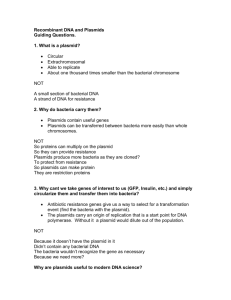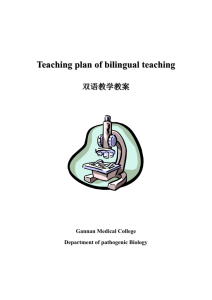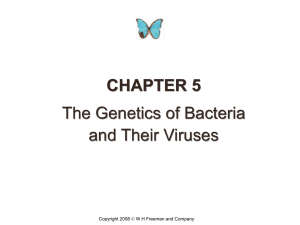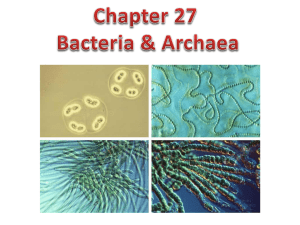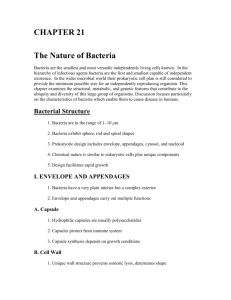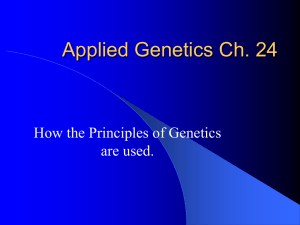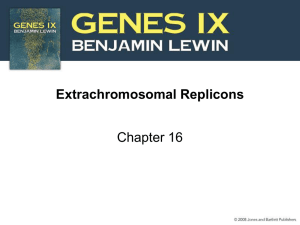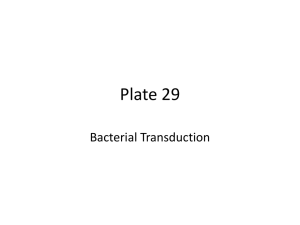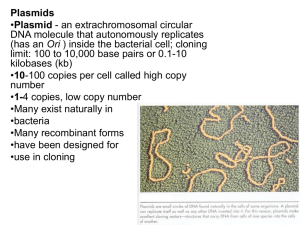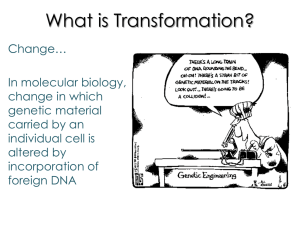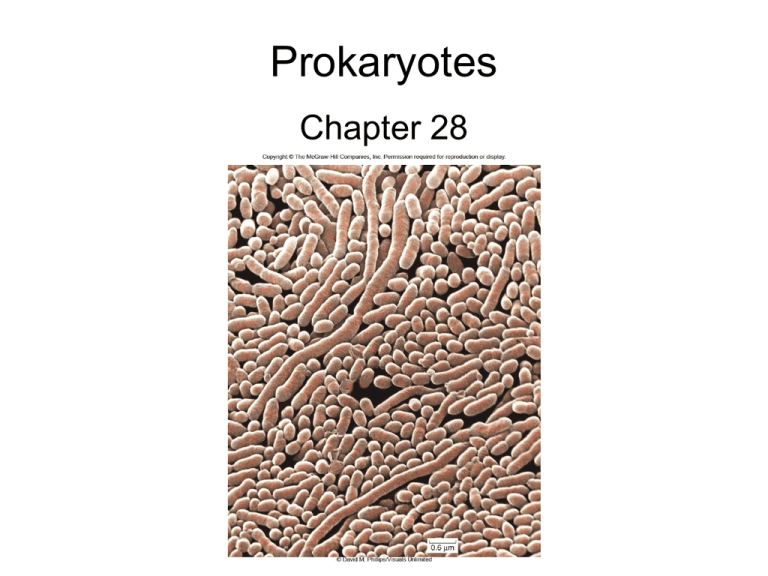
Prokaryotes
Chapter 28
The First Cells
• Microfossils are fossilized forms of
microscopic life
– Oldest are 3.5 billion years old
– Seem to resemble present-day prokaryotes
2
• Stromatolites
are mats of
cyanobacterial
cells that trap
mineral deposits
– Oldest are 2.7
billion years old
– Modern forms
are also known
3
• Unicellularity
– Most are single-celled
– Colony-forming
– Some can form complex biofilms
• Cell size
– Most are less than 1 mm in diameter
• Chromosome
– Single circular double-stranded DNA
– Found in the nucleoid region of cell
– Often have plasmids
• Cell division
– Most divide by binary fission
4
• Genetic recombination
– Occurs through horizontal gene transfer
• Internal compartmentalization
– No membrane-bounded organelles
• Flagella
– Different from eukaryotic flagella
• Metabolic diversity
– Oxygenic and anoxygenic photosynthesis
– Chemolithotrophic
5
Prokaryotic Cell Structure
• 3 basic shapes
– Bacillus – Rod-shaped
– Coccus – Spherical
– Spirillum – Helical-shaped
6
• Cell wall
– Peptidoglycan forms a rigid network
• Maintains shape
• Withstands hypotonic environments
• Archaea have a similar molecule
– Gram stain
• Gram-positive bacteria have a thicker
peptidoglycan wall and stain a purple color
• Gram-negative bacteria contain less peptidoglycan
and do not retain the purple-colored dye – retain
counterstain and look pink
7
8
• Gram positive bacteria
– Thick, complex network of peptidoglycan
– Also contains lipoteichoic and teichoic acid
• Gram negative bacteria
– Thin layer of peptidoglycan
– Second outer membrane with lipopolysaccharide
– Resistant to many antibiotics
9
• S-layer
– Outside of peptidoglycan or outer membrane
layers in gram-negative and gram-positive
bacteria
– Diverse functions – often involves adhesion
• Capsule
– Gelatinous layer found in some bacteria
– Aids in attachment
– Protects from the immune system
10
• Flagella
– Slender, rigid, helical structures
– Composed of the protein flagellin
– Involved in locomotion – spins like propeller
• Pili
– Short, hairlike structures
– Found in gram-negative bacteria
– Aid in attachment and conjugation
11
12
• Endospores
– Develop a thick wall around their genome and
a small portion of the cytoplasm
– When conditions improve can germinate and
return to normal cell division
– Bacteria causing tetanus, botulism, and
anthrax
13
• Nucleoid region
– Contains the single, circular chromosome
– May also contain plasmids
• Ribosomes
– Smaller than those of eukaryotes
– Differ in protein and RNA content
– Targeted by some antibiotics
14
Prokaryotic Genetics
• Prokaryotes do not reproduce sexually
• 3 types of horizontal gene transfer
– Conjugation – cell-to-cell contact
– Transduction – by bacteriophages
– Transformation – from the environment
• All 3 processes also observed in archaea
15
Conjugation
• Plasmids may encode
advantageous info
– Are not required for normal
function
• In E. coli, conjugation is
based on the presence of
the F plasmid (fertility
factor)
– F+ cells contain the plasmid
– F- cells do not
16
cell produces F pilus that connects it to F cell
•
• Transfer of F plasmid occurs through
conjugation bridge
• F plasmid copied through rolling circle
replication
• The end result is two F+ cells
F+
17
• The F plasmid can integrate into the bacterial
chromosome
– Events similar to crossing over in eukaryotes
– Homologous recombination
• Hfr cell (high frequency of recombination)
– F plasmid integrated into chromosome
– Replicated every time host divides
• The F plasmid can also excise itself by reversing
the integration process
– An inaccurate excision may occur picking up some
chromosomal DNA – F′ plasmid
18
19
Please note that due to differing
operating systems, some animations
will not appear until the presentation is
viewed in Presentation Mode (Slide
Show view). You may see blank slides
in the “Normal” or “Slide Sorter” views.
All animations will appear after viewing
in Presentation Mode and playing each
animation. Most animations will require
the latest version of the Flash Player,
which is available at
http://get.adobe.com/flashplayer.
20
Transduction
• Generalized transduction
– Virtually any gene can be transferred
– Occurs via accidents in the lytic cycle
– Viruses package bacterial DNA and transfer it
in a subsequent infection
• Specialized transduction
– Occurs via accidents in the lysogenic cycle
– Imprecise excision of prophage DNA
– Only a few host genes can be transferred
21
Copyright © The McGraw-Hill Companies, Inc. Permission required for reproduction or display.
Infection with Phage
Phage adheres to cell.
Phage DNA is injected in to cell. Phage DNA is replicated and
host DNA is degraded.
Phage particles are packaged
with DNA and are released.
Infection with Transducing Phage
Cell contains DNA from donor.
DNA is incorporated by
homologous recombination.
Phage injects a piece of
chromosomal DNA.
Transducing phage
adheres to cell.
22
Please note that due to differing
operating systems, some animations
will not appear until the presentation is
viewed in Presentation Mode (Slide
Show view). You may see blank slides
in the “Normal” or “Slide Sorter” views.
All animations will appear after viewing
in Presentation Mode and playing each
animation. Most animations will require
the latest version of the Flash Player,
which is available at
http://get.adobe.com/flashplayer.
23
Transformation
• Natural transformation
– Occurs in many bacterial species, including
Streptococcus which was studied by Griffith
– DNA that is released from a dead cell is
picked up by another live cell
– Encoded by bacterial chromosome
• Not an accident of plasmid or phage biology
24
• Artificial transformation
– Some species do not naturally undergo
transformation
– Accomplished in the lab
– Used to transform E. coli for molecular cloning
25
Please note that due to differing
operating systems, some animations
will not appear until the presentation is
viewed in Presentation Mode (Slide
Show view). You may see blank slides
in the “Normal” or “Slide Sorter” views.
All animations will appear after viewing
in Presentation Mode and playing each
animation. Most animations will require
the latest version of the Flash Player,
which is available at
http://get.adobe.com/flashplayer.
26
• R (resistance) plasmids
– Encode antibiotic resistance genes
– Acquire genes through transposable elements
– Important factor in appearance of antibiotic
resistant strains of Staphylococcus aureus
• Virulence plasmids or transduction
– Encode genes for pathogenic traits
– Enterobacteriaceae
– E. coli O157:H7 strain
27
• Mutations can arise spontaneously in
bacteria as with any organism
– Radiation and chemicals increase likelihood
• Auxotrophs are nutritional mutants
– Studied using replica plating
• Mutations (and plasmids) can spread
rapidly in a population
– Methicilin-resistant Staphylococcus aureus
(MRSA)
– Vancomycin-resistant Staphylococcus aureus
(VRSA)
28
Prokaryotic Metabolism
• Acquisition of Carbon
– Autotrophs – from inorganic CO2
• Photoautotrophs – energy from Sun
• Chemolithoautotrophs – energy from oxidizing
inorganic substances
– Heterotrophs – from organic molecules
• Photoheterotrophs – light as energy source but
obtain organic carbon made by other organisms
• Chemoheterotroph – both carbon atoms and
energy from organic molecules
– Humans are also an example
29
• Type III secretion system
– Found in many gram-negative bacteria
– Molecular syringe to inject virulence proteins
into host cell cytoplasm
– Yersinia pestis (bubonic plague), Salmonella,
Shigella
30
Human Bacterial Disease
• In the early 20th century, infectious
diseases killed 20% of children before the
age of five
– Sanitation and antibiotics considerably
improved the situation
• In recent years, however, many bacterial
diseases have appeared and reappeared
31
Tuberculosis (TB)
•
•
•
•
•
Scourge for thousands of years
Mycobacterium tuberculosis
Afflicts the respiratory system
Thwarts immune system
Easily transferred from person to person
through the air
• Multidrug-resistant (MDR) strains are very
alarming
32
• Dental caries (tooth decay)
– Plaque consists of bacterial biofilms
– Streptococcus sobrinus ferments sugar to
lactic acid
– Tooth enamel degenerates
• Peptic ulcers
– Helicobacter pylori is the main cause
– Treated with antibiotics
33
Sexually transmitted diseases (STDs)
• Gonorrhea
– One of the most prevalent communicable
diseases in North America.
– Neisseria gonorrhoeae
– Transmitted through exchange of body fluids
– Can pass from mom to baby via birth canal
• Chlamydia
– Chlamydia trachomatis
– “Silent STD” – incidence has skyrocketed
– Can cause PID and heart disease
34
• Syphilis
– Treponema pallidum
– Transmitted through sex or contact with open
chancre
– Can pass from mom to baby via birth canal
– Four distinct stages
• Primary – Chancre – highly infectious
• Secondary – Rash – infectious
• Tertiary – Latency – no longer infectious but
attacking internal organs
• Quaternary – Damage now evident
35

